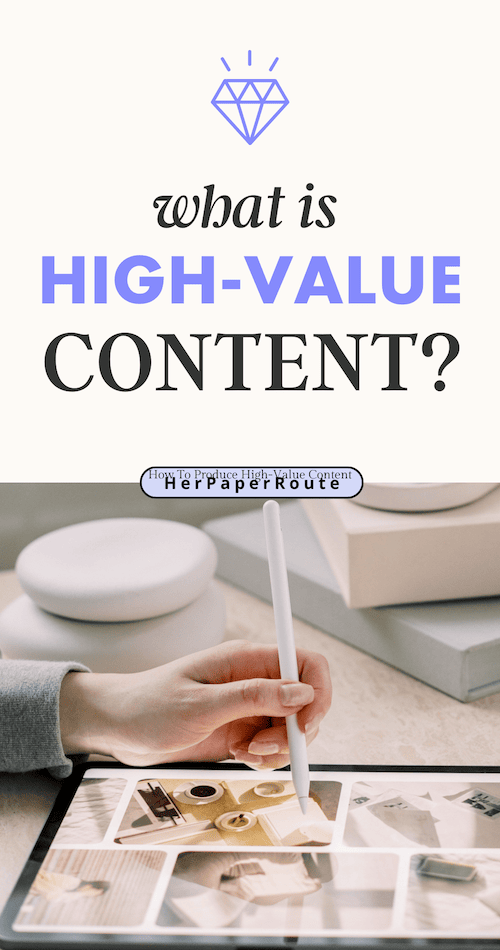When my clients ask me how to make more money, they usually need to focus on producing high-value content. But, what exactly is high-value content, you ask?
Well, as a content creator, do you ever feel like you are running in circles on the hamster wheel of production, constantly churning out new articles and videos, but getting nowhere?
If so, then you might be producing low-value content, or, focusing too much on quantity over quality.
Whereas high-value content does more with less! Because here’s the real kicker – not all content is created equal.
Today, we’re kicking back and having a chat about the magic behind high-value content and, more importantly, how you can whip it up without breaking your lil’ hamster sweat.
How To Produce High-Value Content So You Can Do More With Less

Now, we’ve all heard the whole “content is king” spiel, and we know that search engines want fresh content on the regular. But let’s be real – it’s not just about quantity.
It’s about giving your audience something worth their time. Think of this as your guide to creating content that doesn’t just fill space but actually does something.
In a world saturated with information, creating content that truly resonates and delivers substantial value to your audience is crucial.
No need for a PhD in content creation – just a desire to make your content matter.
What is High-Value Content?
So, what exactly is high-value content?
It’s content that goes beyond the superficial, offering your audience insights, solutions, and experiences that genuinely matter.
How To Produce High-Value Content, WIth Examples
Let’s break it down with some examples to illuminate the concept.
1. In-Depth Guides and Tutorials
Imagine crafting comprehensive guides that not only address your audience’s questions but guide them through every step of the process.
Whether it’s mastering a new skill or navigating a complex industry, high-value content provides a roadmap for success.
2. Speak From Personal Experience
Anyone can copy and paste something from an ai writing tool. But to really wow your audience, share your real-world experience and opinions on the given topic.
Your perspective is one the #1 best tools for producing high-value content in your business.
3. Case Studies
Explore real-world examples that showcase your expertise or highlight the success stories of your clients.
Your audience craves actionable insights, and case studies provide a tangible demonstration of the value you bring to the table, while inspiring them to know such success is possible for them too.
4. Expert Interviews and Insights
Collaborate with industry leaders and subject matter experts to bring fresh perspectives to your audience.
Conduct in-depth interviews that extract valuable insights, offering your audience exclusive access to expert knowledge.
5. Data-Driven Content
Harness the power of data to support your claims and provide evidence for your audience.
Infographics, research reports, and statistical analyses lend credibility and substance to your content, positioning you as an authority in your field.
6. Interactive Content
Break away from the passive consumption of information. High-value content encourages engagement.
Think quizzes, assessments, and interactive tools that empower your audience to actively participate in the learning process.
7. Thought Leadership Pieces
Position yourself as a thought leader by sharing your unique perspectives on industry trends, challenges, and opportunities.
Craft insightful articles, LinkedIn posts, podcast episodes, and keynote presentations that demonstrate your forward-thinking approach.
Ok Then, What is Low-Value Content?
On the contrary, low-value content is just the opposite. Low-value content refers to material that lacks substance, relevance, or meaningful engagement for its intended audience.
It’s the kind of content that might be hastily produced, click-batey, or boring, without much thought or strategic planning.
Characteristics of low-value content often include the following.
😒 Lack of Relevance
Content that doesn’t align with the interests, needs, or queries of the target audience is considered low value. It fails to address the concerns or provide information that the audience is seeking.
😒 Poor Quality
Content that is riddled with grammatical errors, inaccuracies, or lacks visual appeal can be deemed low value.
This type of content may not only fail to capture the audience’s attention but may also undermine the credibility of the creator.
😒 Overemphasis on Quantity
Quantity does not always equate to quality. Content produced solely to meet a quota or schedule without a focus on providing value to the audience often falls into the low-value category.
😒 Lack of Originality
Content that is a mere regurgitation of existing information without adding any unique perspective, insight, or value is considered low value. Originality and a fresh viewpoint contribute significantly to content quality.
😒 Short-Term Focus
Content that is created with a short-term, immediate gain in mind, rather than considering its long-term impact on the audience, may be classified as low value.
This could include clickbait or sensationalized content.
😒 Ignoring Audience Engagement
Content that doesn’t encourage audience interaction, discussion, or feedback may be perceived as low value. Engagement is a crucial aspect of creating content that resonates with the audience.
All in all, low-value content doesn’t contribute positively to the audience’s experience or knowledge.
How To Produce High-Value Content – Conclusion
Finally, high-value content is an investment in your audience’s success.
It’s about going beyond the surface, delivering substance that educates, inspires, and empowers.
If you consider the impact your content has on those who consume it, then my guess is you are already producing high-value content!
Keep striving for excellence, provide genuine value, relevance, and a focus on audience needs. This all helps elevate the overall quality of your content strategy, and positions you as a thought leader in your niche.
